Vol 3 No. 10 TROPIC LIGHTNING NEWS March 4, 1968
Index
| Unit Page | Unit Page | Unit Page | Unit Page |
| 1st Bde 2 | 2/14 7 | 2/27 6 | 49th ARVN 4 |
| 1/5 Photo 4 | 2/14 7 | 25th Inf Div 1 | 5/2 Arty Photo 7 |
| 1/5 Photo 4 | 2/14 8 | 3/22 6 | 5/2 Arty Photo 7 |
| 1/27 1 | 2/14 Photo 8 | 3/22 6 | 5/2 Arty 7 |
| 1/27 Photo 1 | 2/22 1 | 3/22 6 | Montagnards 3 |
| 1/27 4 | 2/27 4 | 3/22 6 | Gen. Westmoreland 8 |
| 1/27 8 | 2/27 Photo 4 | 4/9 8 | MG FK Mearns 8 |
COL Hood New Division Chief of Staff
 CU CHI - COL Burton F. Hood, Jr., a 1943 graduate of the U.S. Military
Academy, has succeeded COL Jasper J. Wilson as the 25th Inf Div Chief of Staff.
CU CHI - COL Burton F. Hood, Jr., a 1943 graduate of the U.S. Military
Academy, has succeeded COL Jasper J. Wilson as the 25th Inf Div Chief of Staff.
COL Wilson has been reassigned as the deputy post commander at Fort Huachuca,
Ariz. COL Hood came to the Tropic Lightning Division from an assignment in
Hawaii as the secretary to the general staff at headquarters, U.S. Army,
Pacific.
After receiving his commission as a second lieutenant of infantry, he was
assigned to the European Theater of Operations and participated in four
campaigns with the 95th Inf Div.
This is the colonel’s second tour of duty in Vietnam, he served previously
with MAAG, Vietnam in 1956-1957. During that tour he was the advisor to the
ARVN Airborne Group at Tan Son Nhut Air Base and conducted many air assaults
into what is now the present Cu Chi base camp area.
Subsequently his CONUS assignments included positions in the office of the
Deputy Chief of Staff, Operation, DA and as the assistant deputy chief for
personnel and administration of the United States Military Academy at West
Point.
The colonel’s military education includes numerous branch and specialty
schools plus graduation from the U.S. Army Command and General Staff College at
Fort Leavenworth, Kan., and the Industrial College of the Armed Forces at Fort
McNair, Washington, D.C. He received an MBA degree in business administration
from the University of Alabama in 1953.
Among his decorations the colonel wears the Bronze Star Medal with one Oak
Leaf Cluster, the Army Commendation Medal with one Oak Leaf Cluster and the
Combat Infantryman’s Badge.
His wife, Marcia, and two sons, Thomas and William, currently reside in
Hawaii while their oldest son, Daniel, is in his first year at The Citadel in
Charleston, S.C. Their only daughter, Kathryn, is married to CPT Leigh Fairbank,
a former member of the 3rd Bde, 25th Div. Col Hood’s mother, Mrs. E.S. Lorentz,
lives in Mahtomedi, Minn.
Wolfhound Risks Life, Saves Four Buddies
A 25th Inf Div radiotelephone operator has been recommended for a valor award
for voluntarily rescuing four wounded men pinned down and stranded by heavy Viet
Cong machine gun fire.
SP4 Ray D. McGuire, son of Mr. and Mrs. Carl McGuire of Frankfurt, Ky., saved
the men during an action in Hoc Mon, a suburb of Saigon, during the Viet Cong
Tet offensive.
McGuire is a member of the 2nd Bde’s Charlie Co, 1st Bn, 27th Inf “
Wolfhounds.”
The action began when his company conducted a helicopter assault into an
enemy-occupied landing zone to reinforce another heavily engaged company.
After being inserted into the landing zone five Wolfhounds crawled behind a
rice paddy dike for protection, four were wounded and the fifth killed.
Meanwhile, according to McGuire, the remainder of the company landed nearby
and began moving towards the five stranded Wolfhounds. Within minutes, he said,
the company came to a standstill in waist deep mud as the Viet Cong poured
rocket, automatic weapons and machine gun fire into their assault line.
“The company commander sent two men from the first platoon,” McGuire
explained, “but they came back and said they couldn’t find them.
“I asked for a chopper to drop smoke on their location, which he did. I
asked the CO if I could go down there. He hesitated at first, but then let me
go.” McGuire then began a 150-meter crawl through muddy rice paddies while
enemy fire cracked overhead. “When I got to the wounded, I had to go over the
dike,” he explained.
“As I rolled over it, shots hit right next to me. I rolled into the water on
the side the wounded men were on. I started hollering at them, but they just
lay there. They did not want to move.
“One man said he was a medic, but he was in a daze. I talked him into going
over the dike. Then I had to convince him to help me get the other wounded over
the dike. We eventually got all three across like that.”
At that point, McGuire called for support from armed helicopters, which soon
blazed away at the enemy positions with their “mini-guns.” Starting to drag the
men back to safety, the RTO came upon something he thought was a dud mortar
round. He picked it up and tossed it over the dike.
“When I came to the last man he was dead. I pulled him along a ditch, but it
was too difficult.”
He returned to the wounded, eventually leading them back to friendly lines.
Medical evacuation choppers picked them up and delivered them to an evacuation
hospital.
McGuire joined the Army in Aug 1965. Since his arrival in Vietnam Oct 1967
he has been awarded the Combat Infantryman’s badge and the purple heart.
Not Quite Everyone Informed
By SP4 Robert Rossow
3RD BDE - Limitless are the stories revolving about people who fail to get
the word, but here is one with a novel twist.
Several days ago fire support base Burt, the site of the New Year’s Day
battle of Soui Cut near the Cambodian border, was closed down and the artillery
elements, escorted by the 2nd Bn (Mech), 22nd Inf, 25th Inf Div, moved out.
However, the Viet Cong, apparently unaware that the position was empty,
continued sporadic mortar attacks on the support base, concluding with a
spectacular 150 to 200 round barrage the evening after everyone had gone, and
observed only by a few passing spotter planes.
The sole conclusion is that Charlie definitely did not get the word.
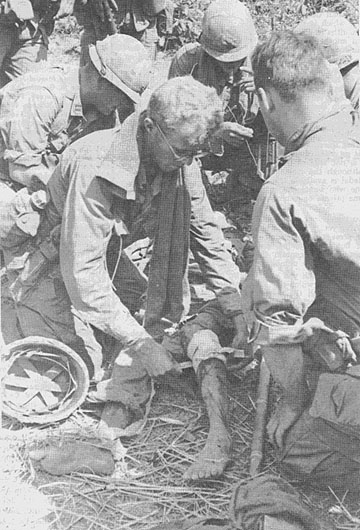 |
FIRST AID FOR THE ENEMY - PFC Michael T. Burris from Modesto, Calif., treats a wounded North Vietnamese soldier after a heavy fire fight 6 kms north of Saigon, where the 1st Bn, 27th Inf, has been conducting sweeps since Jan 30. (Photo By SP4 B. Roessler) |
Page 2 TROPIC LIGHTNING NEWS March 4, 1968
Decorated
| SILVER STAR | |
|
LTC William L. Albright, HHB, 2nd Bn, 77th Arty LTC John M. Henchman, HQ, 4th Bn, 9th Inf LTC Thomas U. Harrold, HHC, 3rd Bn, 22nd Inf |
MAJ Luther C. Vaughn, HHC, 1st Bn, 27th Inf CPT Michael A. Moran Jr., Co C, 1st Bn, 27th Inf |
|
DISTINGUISHED FLYING CROSS |
|
|
COL Edwin W. Emerson, HHC, 2nd Bde MAJ Stephen R. Pawlik, HHC, 2nd Bde 1LT James W. Halley, Co A, 25th Avn Bn WO1 George T. Walter, 116th Aslt Hel Co |
WO1 Larry B. Harlamert, D Trp, 3rd Sqdn, 4th Cav WO1 Patrick J. Bilyk, HHC, 3rd Bde WO1 Thomas J. Richardson, Co A, 25th Avn Bn |
|
BRONZE STAR (HEROISM) |
|
|
CPT Albert G. Killgrove, Co A, 4th Bn, 9th Inf CPT Charles P. Watkins, HHC, 1st Bn (Mech), 5th Inf CPT Kenneth W. Lucas, Co C, 1st Bn (Mech), 5th Inf CPT John R. Wells Jr., Co B, 1st Bn (Mech), 5th Inf 1LT Denton C. Jones, Co A, 1st Bn, 27th Inf 1LT Gary K. Weir, A Btry, 2nd Bn, 77th Arty |
1LT Joe M. Sample, Co B, 1st Bn (Mech), 5th Inf 2LT John A. Anderson, Co B, 1st Bn (Mech), 5th Inf 2LT Joseph J. McCusker, Co B, 1st Bn (Mech), 5th Inf PSG Kenneth J. Gardner, Co D, 2nd Bn, 27th Inf SGT David Dela Torre, HHC, 1st Bn (Mech), 5th Inf SP5 James E. Burke, HHC, 1st Bn (Mech), 5th Inf |
|
ARMY COMMENDATION MEDAL (HEROISM) |
|
|
SP5 Phillip J. Busby, 116th Aslt Hel Co, 269th Avn Bn SP5 Jerry E. Delinger, 116th Aslt Hel Co, 269th Avn Bn SP5 Peter R. Molina, 116th Aslt Hel Co, 269th Avn Bn SGT Mariano Miguel Jr., 116th Aslt Hel Co., 269th Avn Bn SGT Clyde M. Greathouse,-116th Aslt Hel Co, 269th Avn Bn SP5 David A. Kersey, 116th Aslt Hel Co, 269th Avn Bn SP5 Johnny E. Kilgore, 116th Aslt Hel Co, 269th Avn Bn SP5 Roger W. Brooks, 116th Aslt Hel Co, 269th Avn Bn |
SP5 James G. Torlos, 116th Aslt Hel Co, 269th Avn Bn SP4 Gregory C. Anderson, 116th Aslt Hel Co, 269th Avn Bn SP4 Troy D. Carmick, C Btry, 2nd Bn, 77th Arty SP4 James D. Gogerty, Co D, 2nd Bn, 27th Inf SP4 Jack J. Szentmiklosi, 116th Aslt Hel Co, 269th Avn Bn SP4 Robert B. Divon, 116th Aslt Hel Co, 269th Avn Bn SP4 Jerry W. Ockinga, 116th Ash Hel Co, 269th Avn Bn PFC Frank A. Emery, Co D, 2nd Bn, 12th Inf |
|
ARMY COMMENDATION MEDAL (MERIT) |
|
|
CPT Dennis D. K. Ching, HHC, 25th S&T Bn CPT Joseph L. Richardson, Co B, 25th S&T Bn CPT Steve R. Walters, HH&S Btry, 1st Bn, 8th Arty CPT Edward A. Burton, Co B, 25th Med Bn 1LT Patricia D. Cooke, 12th Evac Hosp (SMBL) 1LT Mary J. Hyland, 12th Evac Hosp (SMBL) 1LT Carolyn A. McLeavey, 12th Evac Hosp (SMBL) 1LT Joanne M. Spencer, 12th Evac Hosp (SMBL) 1LT Virginia M. Steel, 12th Evac Hosp (SMBL) SGM Lawrence A. Ditton, HH&S Btry, 1st Bn, 8th Arty MSG Eduardo E. Villafane, HH&S Btry, 1st Bn, 8th Arty SFC Robert S. Mahoe, HHC, 2nd Bn, 27th Inf SFC William R. Dinino, HQ & Co A, 725th Maint Bn SSG James D. White, A Trp, 3rd Sqdn, 4th Cav SSG Dernard M. Adams, Co A, 125th Sig Bn SP6 Carrol E. Williams, Co B, 25th Med Bn SSG Peter R. Damallie, Co E, 725th Maint Bn SSG Stanley Elliott, Co C, 2nd Bn, 34th Armor SSG Thomas McGirt, 18th Military History Det |
SGT Pablo D. Detorres, Co B, 125th Sig Bn SGT Lloyd G. Kirkland, Co C, 65th Engr Bn SGT Willie Nelson, HHC, 1st Bde SGT J. D. Smith, Co B, 65th Engr Bn SGT James E. Gouthier, Co C, 65th Engr Bn SGT George E. Konsmo, B Btry, 1st Bn, 8th Arty SGT David P. Mayville, HHB, 25th Inf Div Arty SP5 Gary W. Riley, HHC, 2nd Bn (Mech), 22nd Inf SP5 Robert L. Wyatt, Co A, 25th S&T Bn CPL Thomas J. Penrose, C Btry, 7th Bn, 11th Arty SP4 Cecil L. Beasley, 25th Admin Co SP4 Larry C. Crain, HHT, 3rd Sqdn, 4th Cav SP4 James Friar, HHC, 2nd Bn (Mech), 22nd Inf SP4 Gary D. Fletcher, Co C, 65th Engr Bn SP4 La Roye C. Hunter, HHC, 65th Engr Bn SP4 Columbus Jeffery, 25th Admin Co SP4 Glenn O. Leming , HH&Svc Btry, 3rd Bn, 13th Arty SP4 Robert W. Meleney, HHD, 125th Sig Bn |
|
Vietnam Medals AG Section Have you wondered about the Vietnam Service and the Vietnam Campaign medals? The Service medal is an American award which shows service in Vietnam whereas the campaign medal is a Vietnamese award given to those who serve in the country for six months. All military personnel assigned to U.S. Forces in Vietnam (RVN) are authorized the Vietnam Service Medal (VSM) as soon as they arrive in RVN. Each member is authorized to wear one Bronze Service Star on his VSM for each of the following campaign periods during which he was present for duty in Vietnam for at least one day:
|
Free Leave To Wounded In U.S. Hosp
WASHINGTON - Combat soldiers recuperating at hospitals in the U.S. -
including Hawaii and Alaska - now may enjoy government funded travel home for
convalescent leave.
A provision, authorizing the privilege for men wounded or injured by hostile
fire and returned to the U.S. for recuperation, was included in the military pay
bill signed by the President late last year.
After putting together some of the necessary medical and finance details, the
Army now has sent a message (DA 850009) telling the field how to use the new
sick leave travel deal.
“Members are entitled to travel and transportation allowances are
authorized,” the Army says, “to make one round trip at government expense in
connection with illness or injury incurred during each tour of duty involving
entitlement to hostile fire pay.
“Under current policy, members evacuated to the U.S. are assigned when
possible to the medical facility which is nearest the member’s wife or family to
which he would normally perform travel for the purpose of convalescence.
Hospital COs are delegated authority to approve the place selected by the member
for convalescent leave travel to be performed in and between the 50 U.S. States
and D.C.”
The Army is cautioning hospital commanders to require justification for
travel to places other than the area of the immediate family to prevent abuse of
the privilege.
Request for convalescent leave travel outside the U.S. must be approved in
Washington.
Chp Anderson Takes Over At First Bde
1ST BDE - Chaplain (MAJ) Alister Anderson of Annapolis, Md., recently became
chaplain of the 25th Inf Div’s 1st Bde.
Chaplain Anderson was previously assigned to the 25th Inf Div Artillery,
where he served as chaplain for six months.
A 1945 graduate of the U.S. Naval Academy at Annapolis, Md., and an ordained
priest in the Episcopal Church, Chaplain Anderson is married and the father of
two boys and two girls.
The TROPIC LIGHTNING NEWS is an authorized publication of the 25th
Infantry Division. It is published weekly for all division units in the Republic of
Vietnam by the Information Office, 25th Infantry Division, APO San Francisco
96225. Army News Features, Army Photo Features, Armed Forces Press Service and Armed
Forces News Bureau material are used. Views and opinions expressed are not necessarily
those of the Department of the Army. Printed in Tokyo, Japan, by Pacific Stars and
Stripes.
MG F. K. Mearns . . . . . . . . . Commanding General
MAJ Bernard S. Rhees. . . . . Information Officer
1LT Larry Rottmann . . . . . . . Officer-in-Charge
SP5 Terry Richard . . . . . . . . Editor
SP4 Dave Cushman . . . . . . . Editorial Assistant
Page 3 TROPIC LIGHTNING NEWS March 4, 1968
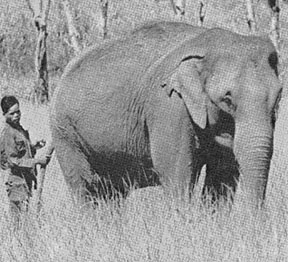 |
Sporting a smile and a ‘bowl’ haircut, this Montagnard boy reflects the
ruggedness of the mountain people. (right) The elephant proves his worth. He is used by the Vietnamese to move heavy loads. The highly trained beasts do the work of many men. (left) |
 |
|
The People
SOUTH |
|
Most of Vietnam’s short, handsome and fine-boned people are ethnic
Vietnamese.
The overwhelming majority (85 per cent) of Vietnam’s 15.5 million inhabitants
are farmers. About half of the total population lives in Vietnam’s rice land, an
area which extends from just north of Saigon to the delta in the south.
The precise origin of the ethnic Vietnamese is lost in legend. According to
one legend however, the kingdom of the Viets was founded in northern Vietnam
nearly 3,000 years before Christ - about the same time as Egyptians were laying
the basis of a highly-developed civilization in north Africa.
Ancient Chinese accounts tell of Viet states south of China around 500 B.C.
The ancestors of the present Vietnamese seem to have descended from a mixture of
two distinct Asiatic types - a Sino-Tibetan and early Malay or Indonesian type.
Most Vietnamese seem to be physical and cultural descendents of this mingling.
Minorities
About one-seventh of the country’s inhabitants are members of minority
groups. The largest single minority group, the Chinese, is estimated to number
about one million.
The overwhelming majority of Vietnam’s Chinese live in Cholon, Saigon’s twin
city.
The second largest minority group is primitive highlanders called Montagnards
(mountaineers) by the French. Living in isolation in the country’s highlands
they have maintained separate and complicated tribal customs.
The country’s approximately one-million Chinese and the 800,000 Montagnards
practice social customs quite different from ethnic Vietnamese.
The main concern of the Chinese urban community has been commerce. Chinese
have been migrating to Vietnam for centuries and during the 1930s when Japan
invaded China an estimated 400,000 entered Vietnam from China’s southern
provinces.
Chinese Influence
The economic impact of the Chinese population has been greatly out of
proportion to its numbers. Though they formed a small percentage of the total
population, the Chinese controlled 90 per cent of all Vietnamese retail trade in
1956. Chinese control was also great in rice brokerage, lumbering and goods
transport.
The Chinese have maintained their own schools and they continue to form
social and fraternal organizations based upon place of origin in China. They
have also produced their own Chinese language newspapers.
Mountaineers
Montagnards tribes form the second largest minority group. Little more than
speculation exists about their origin. Their earliest ancestors are thought to
have come to Vietnam in very early times. Later invasions by Mongolian peoples
of China drove them into the highlands where some of the invaders intermarried
with early Montagnards.
Shifting agriculture is the main economic support of the Montagnard group
which inhabits Vietnam’s central plateau.
Shifting agriculture involves clearing land by burning and then cultivating
it until it is exhausted - usually after three or four years.
Principal sub-groups of the Montagnards are the Rhades, Jarai and Bahnar
tribes.
Rhades - about 130,000 of them - live according to a system of clan and
tribal divisions consisting of closely related families. Clans are based on a
lineage traced through the female side of the family and marriage within a clan
is prohibited.
About 60,000 Jarai Montagnards live in Pleiku Province. Descent and
relationship is reckoned through the female family line and land holding is also
based upon maternal lineage.
Bahnar tribesmen do not establish clan membership. Families are the most
important social unit. Families own and farm land parcels.
Khmers and Chams
Two other minority groups in Vietnam - the Khmers and Chams - are distinct
from both Vietnamese and Montagnards.
Khmers are related to the dominant stock of Cambodia and came under
Vietnamese government control during the eighteenth century. Since then, they
have been assimilated but remain mostly Cambodian in language and culture.
About 35,000 Chams live in scattered villages of the central lowlands and the
area northwest of Saigon near the Cambodian border.
Descendants of a highly-developed civilization along the coast, they now live
in thatched huts. Ruined towers of their once-prosperous cities still stand
along the coast as monuments to their lost civilization.
Chams disapprove marriage to outsiders and trace their descent and
inheritance through the female line.
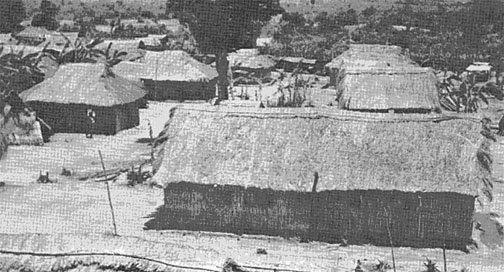 |
|
Montagnard Village - Construction Is of Bamboo and Straw. |
Page 4-5 TROPIC LIGHTNING NEWS March 4, 1968
Story and Photos By SP5 George Pullen
2ND BDE - Lying in rice paddies and firing everything from World War II
machine guns to modern recoilless rifles, South Vietnamese infantrymen are
undergoing a rigorous training program sponsored by the 2nd Bde, 25th Inf Div.
The Army of the Republic of Vietnam (ARVN) soldiers belong to the 49th
Regiment, 25th ARVN Div, centered in Duc Lap, Hau Nghia Province.
So far, three of the regiment’s four battalions have completed the five-week
training course in the rice paddies and forests around Duc Lap. Two officers and 11 enlisted men from the 2nd Bde’s 1st and 2nd Bns, 27th Inf,
and the 1st Bn (Mech), 5th Inf, spend long hours in front of charts, blackboards
and on rifle ranges to train the Vietnamese.
The course is a rough cross between standard American basic and advanced
individual training courses. The two principal areas are weaponry and general
subjects.
Subjects include instructions on the 81mm mortar; the 30-caliber and
50-caliber machine gun; the BAR, M-1 and carbine; the 45-caliber pistol and the
45-caliber submachine; the 57mm recoilless rifle and the M-79 grenade launcher.
General subjects consist of map reading and land navigation, mines and booby
traps, first aid, airmobile familiarization, field fortifications, patrolling,
and offensive and defensive tactics from squad to company level.
For a graduation exercise, the entire battalion conducts a three-day
operation, including sweeps, reconnaissance in force and at least one day of
airmobile combat assaults.
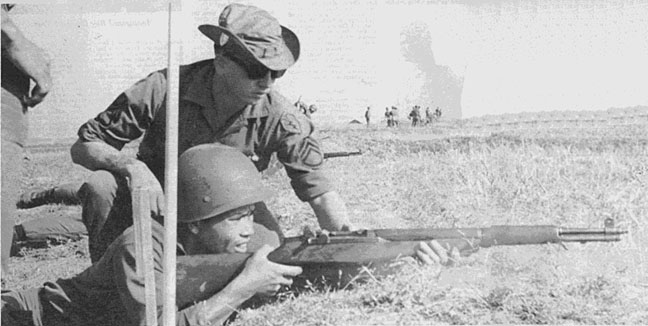 |
| ON THE FIRING LINE - SSG Randolph Henderson of the 1st Bn (Mech), 5th Inf, points out proper firing techniques to a Vietnamese soldier learning to fire the M-1 rifle. |
Page 6 TROPIC LIGHTNING NEWS March 4, 1968
Two Actions
Fighting Nets 14
3RD BDE - Reconnaissance In Force east of Cu Chi brought on a strange battle
for a unit of the 3rd Bde, 25th Inf Div.
Alpha Co, 3rd Bn, 22nd Inf was about to search a VC bunker complex. Suddenly
several Viet Cong in a large bunker opened up with a fierce hail of gunfire,
pinning down the lead elements of the American company. Three soldiers were
wounded, two fatally.
When M-79 and small arms fire, plus fragmentation grenades failed to dislodge
the enemy, the company pulled back.
“They were really dug in there,” commented CPT Herbert C. Chancey, “so we
pulled back and called in an air strike.”
Several hours of bombing and strafing stopped most of the gunfire but an
occasional sniper round snapped through the air.
Cautiously the company moved up on the bunker and silenced the sniper. In
all, five enemy were killed, two AK-47 rifles and an RPG rocket launcher were
found inside the bunker.
In Another Action
During an operation east of Cu Chi a unit of the 3rd Bde narrowly escaped
being surrounded by a heavily armed Viet Cong force.
Moving north through swampy terrain, Charlie Co, 3rd Bn, 22nd Inf discovered
fresh food and other signs of enemy activity.
Minutes later the Viet Cong opened fire on the lead elements with heavy
automatic weapons and RPG fire. Withdrawing, the American company returned the
enemy fire as they maneuvered away.
Then the company commander, 1LT Charles J. Boyle called in three air strikes
on the enemy force. The troops continued to pour in fire on the VC as the jets
and gunships pounded the bunkers.
After the bombing the company moved back through the area and located 14 VC
bodies.
“When we discovered well over 50 bunkers with tunnels, it was obvious that
this was a base camp for a large VC unit,” commented Boyle.
3rd Brigade Regulars Kill 55 In Four Days
3RD BDE - Recent fighting in the Saigon area brought the 3rd Bn, 22nd Inf
into combat south of Cu Chi.
With several companies of Viet Cong headed for the village of Cu Chi, troops
of the 3/22 were called in to assist the local ARVN forces in pushing back the
enemy.
Alpha, Bravo, and Charlie companies swept through the village, killing
several VC infiltrators and taking 21 detainees.
Delta Co accounted for 27 of the enemy dead in heavy fighting in and around
the smaller villages near Cu Chi base camp.
As the Viet Cong companies scattered throughout the area, the “Regular”
troops conducted highly effective search and destroy missions among the dusty
rice fields. Constant enemy fire from rockets and automatic weapons produced
U.S. casualties, but the dispersed enemy paid a high price. In four days of
fighting 55 enemy were killed.
LTC Flint 3/22 CO
3RD BDE - With his battalion engaged in heavy combat outside of Cu Chi, LTC
Roy K. Flint recently assumed command of the 3rd, 22nd Inf. LTC Thomas U.
Harrold, former battalion commander, was unable to return to Dau Tieng so the
customary change of command ceremony was omitted.
A native of St. Petersburg, Fla., Flint spent six months with USARV
Headquarters prior to taking command of the “Regulars”.
After a brief handshake ceremony with the former CO, Colonel Flint took to
the air in an observation helicopter to direct his battalion in its fight
against the Viet Cong.
Air, Gunships Kill 15 VC
3RD BDE - A recent Viet Cong attack on a unit of the 3rd Bde at Dau Tieng
triggered a combined air and ground attack that resulted in 15 enemy dead.
Advancing across open terrain east of Cu Chi, Alpha Co, 3rd Bn, 22nd Inf
“Regulars” came under heavy fire from an estimated VC platoon.
Reacting quickly, Capt Herbert C. Chancey, Alpha CO from Augusta, Ga. ordered
a covering base of fire to support the withdrawal of the company so that
tactical air and gunships could be called into the area of the intense enemy
fire.
Several hours later the company cautiously moved back into the bomb-torn VC
base camp, immediately finding six enemy bodies.
‘Somethings’ And Flashlights Create Hectic Night On LP
2ND BDE - Water buffaloes and Viet Cong with flashlights make for restless
nights, according to one 25th Inf Div rifleman.
SP4 David B. Posey of Tallahassee, Fla., had moved halfway to his position on
a listening post when he “bumped into something.”
As the 2nd Bn, 27th Inf “Wolfhound” reached out to see what it was, the
“something” snorted.
“It felt, it smelled, and it sounded like a water buffalo,” he said, so Posey
made a quick detour and continued on his way.
“Then we passed a building and heard some mumbling, so we sent the
interpreter inside to tell the people not to be afraid.”
The interpreter cautiously entered the building, then left considerably
faster: No people inside, just six water buffaloes.
Soon after the listening post team reached its position, Viet Cong armed with
flashlights harassed the men. At one point, Posey related, the light from one
enemy nearly blinded him.
“Later on, we spotted a man sneaking up on the position. We opened fire and
next morning we found a blood trail,” he said.
“It was quite a nerve-wracking night,” Posey sighed the next morning.
 |
|
YOU save more than money with |
Page 7 TROPIC LIGHTNING NEWS March 4, 1968
 |
| SILHOUETTE OF DEFENSE - Harassment and interdictory fire from a track mounted twin 40mm cannon (Duster) from B Btry, 5th Bn, 2nd Arty, gives the Viet Cong second thoughts about probing the perimeter of the 25th Inf Div base camp at Cu Chi. (Photo By SP4 Robert Smith) |
Tay Ninh SGM Sees PO 3Class Learns “Army Doing OK Too”
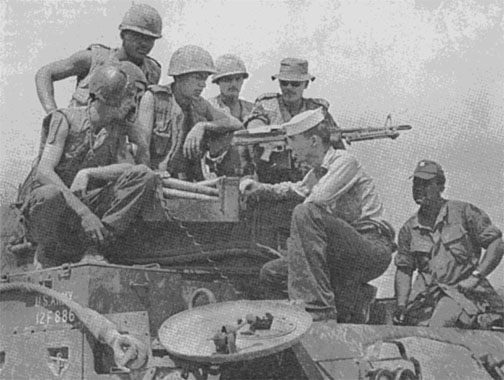 |
| ANYBODY SEEN AN AIRCRAFT CARRIER? - Naval Petty Officer 3rd Class William D. Curran, looks a bit out of place as he talks to the crew of a 40mm tracked vehicle from the 5th Bn, 2nd Arty. Curran was on leave from his ship to visit his father, SGM Curran at Tay Ninh. (Photo By 1LT Larry Rottmann) |
1ST BDE - A long delayed reunion took place at the 25th Inf Div’s 1st Bde
Hqs in Tay Ninh as SGM David F. Curran and his son, Petty Officer 3rd Class
William D. Curran, both from the Bronx, N.Y., were briefly reunited when young
Curran took leave from his ship, the USS Coral Sea, and journeyed to visit his
father who is the Tay Ninh Post sergeant major.
The two men had been trying to see each other since March of 1967 when the
“Top” departed for Vietnam. Petty Officer Curran was on his third and last
cruise in the Gulf of Tonkin when he finally got the paperwork for his leave
approved.
Beaming proudly, “Dad” Curran shook his son’s hand, and told him what a fine
job the Navy was doing. Petty Officer Curran replied with a grin that the Army
was doing OK too.
No Starch, Please
H&H Laundry
1ST BDE - SP4 John W. Hale and SGT Robert W. Hoffman are just two of many men
who use the self service laundromat set up in War Zone C by the Heavy Mortar
Platoon of the 2nd Bn, 14th Inf, during the 25th Inf Div’s Operation
Yellowstone.
Hale, from Sherman, Tex., explained, “Because of the delay in getting our
clothes back from our base camp at Tay Ninh, we decided to start our own
laundry.”
Until some soap powder was found they used regular hand soap to wash their
uniforms. “Our fatigues didn’t come out as clean as they did at the
Quartermaster laundry,” said Hoffman from Oakland, Calif., “but at least we had
a regular change of clothes.”
An artillery ammo canister is used to wash the clothes in, and a small
plastic wash basin serves as a rinse pan. Communications wire stretched between
two bunkers is used as a clothes line.
“Our biggest problem is spotting the incoming helicopters before the strong
downdraft from their rotors hits the laundry area,” remarked Hale. “If we see a
chopper coming, everybody runs over and grabs their wash before it blows away.”
Golden Dragons Use ‘Go’ Carts
1ST BDE - The 3rd Plt of B Co, 2nd Bn, 14th Inf, 25th Inf Div captured two ox
carts on a reconnaissance in force operation near the Cambodian border, and are
putting their unusual “cache” to use by hauling supplies on them at their
forward base camp in Katum, 112 kms north of Saigon.
Sweeping through the jungles, the Infantrymen came upon a network of roads
and trails. “We knew that the Viet Cong were using ox carts in the area because
we could see the deep ruts that the wheels had made,” said SP4 Stanley A. Stull
of Stockton, Calif. Beside one of the trails the tongue of a cart was seen
sticking out from under its protective camouflage, and pulling off the net, the
men found two carts beneath it.
The carts were in good condition, so the GI’s decided to tow them back to
camp. “We often have to move heavy loads and since we don’t have any
wheelbarrows we figured we’d use the carts,” stated PFC Michael E. Sheedy of
Elizabeth, N.J.
Seeing a half-dozen men pulling an ox cart load of mess gear, barbed wire, or
even passengers is a common sight at Katum.
Page 8 TROPIC LIGHTNING NEWS March 4, 1968
Dragons Build Katum’s Far East Hawaiian Village
By SP4 George Phillips
1ST BDE - The 39 men assigned to the Heavy Mortar Plt of the 2nd Bn, 14th Inf,
have developed the ultimate in jungle living conditions only 8 kms from the
Cambodian border, and have done so through the use of expended ammo boxes from
fire missions conducted during the first stage of Operation Yellowstone.
After heliborning into the bamboo thickets in Dec, the men wasted no time
getting their village started. The 1st Bde was extremely busy and it was the
4.2 inch mortars’ responsibility to supply their brigade with plenty of fire
power. The “Four Deuce” section, a more common name for the big mortars, is on
alert 24 hours a day and can be called on to support its battalion in any
direction. It is not an easy job to man the mortar tubes, it takes a great deal
of accuracy and skill.
The platoon fired a total of 13,000 rounds during the first month at Katum,
leaving 6,500 empty boxes to be disposed of. The normal procedure had been to
destroy or burn the major portion of the expended boxes; however, the mortarmen
decided the pine boxes could be put to many uses in the improvement of both
their comfort and protection.
For an entire month, the 39 men combined their “American ingenuity” and built
what is now known as “Katum’s Hawaiian Village.” The unique thing about their
accomplishment has been the fact that they built the village entirely during
their spare time.
After two rounds were expended, the box was filled with dirt. The boxes were
then placed on the walls of the bunkers to provide protection in the event of an
enemy mortar attack. Round after round was fired and box after box was filled
until a virtual fortress was constructed.
The outside wasn’t the end of the ammo boxes uses; floors, wall paneling,
shelves, tables, squad gun cabinets and bunks were also constructed.
The village, which is almost completed, is composed of six major hootches.
Four house the mortar squads, another serves as living quarters for the
administrative group and another is the Fire Direction Center, where targets are
plotted.
The mortar tubes are just outside the door and a round is only as far as a
radio call away. The men stand ready to aid their battalion on its continued
success against the enemy. Between fire missions, the members of Hawaii’s own
25th Inf Div continue to improve and enjoy their version of “Katum’s Hawaiian
Village.”
| SIX STARS - GEN William C. Westmoreland, on a recent visit to Cu Chi, listens attentively to a report from MG F. K. Mearns, 25th Inf Div commanding general. (Photo By 1LT Larry Rottmann) |
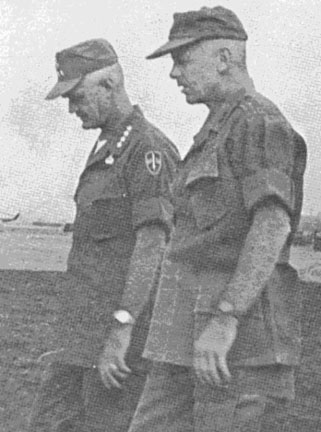 |
Medic Uses Head, Saves Hwy 1 Bridge
2ND BDE - A daring enemy attempt to sabotage a vital bridge 18 kms northwest
of Saigon failed recently when a 25th Inf Div medic spotted a head bobbing in a
canal.
PFC Brandy Slone of Pippa Passes, N.Y., a medic with Alpha Co, 1st Bn, 27th
Inf “Wolfhounds” spotted the head underneath the Hoc Mon Bridge. That structure
spans a large canal which intersects Highway 1 running from Saigon north past
the division Cu Chi base camp to Tay Ninh.
At the same time, other members of the company opened fire on seven enemy
outside their defensive perimeter around the bridge.
According to PSG Salvatore F. Pesta, leader of the company’s third platoon,
his men could not fire because friendly positions were on the other side of the
bridge.
Pesta, of Jonestown, Pa., shouted for the other platoon to move out of the
way, then ordered his men to start pitching hand grenades into the canal.
SP4 Coy Adkins of Oplira, Ala., jumped into the water to clear the area, and
discovered a large object tied to one of the bridge’s supports.
SSG Arthur Collins, the second platoon leader, replaced Adkins in the canal
and discovered the “object” to be a 40-lb satchel charge.
The Easton, Kan., native called for a knife, then began feeling slowly for a
firing device.
“At this time,” Pesta recounted, “I asked Collins if he knew what he was
doing.”
“I hope so,” Collins replied.
“He asked again for a knife,” Pesta continued. “I guess I looked kind of
surprised and informed him it was in his hand. Then he cut the fuse and brought
the charge out of the water.”
White Socks Lose 1st Game To Manchu Sqd
1ST BDE – “I really couldn’t believe my eyes . . . all the Viet Cong were
wearing white bobby socks,” remarked SGT Dave Robbins of Tracy, Minn. “They
looked like a basketball team taking the court.”
The 12 white-footed enemy were spotted by Alpha Co., 4th Bn, 9th Inf, in War
Zone C, 95 kms north-northwest of Saigon.
The 25th Inf Div unit had set up an ambush along a foot path often used by
the Viet Cong.
When the VC moved into the American position, the company opened up with
claymore mines and small arms killing all 12.
“We don’t know why they were wearing the white socks, but it sure made them
easier targets,” recalled SGT Paul Johanovich of St. Louis, Mo. “And we really
socked it to them.”
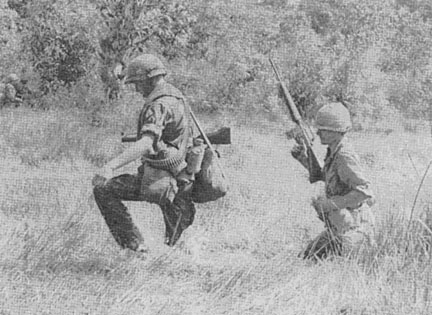 |
| SLOSH TO THE WOODLINE - Members of the 2nd Bn, 14th Inf “Golden Dragons”, head for a woodline after a heliborne assault near Katum during Operation Yellowstone. (Photo By SGT Neil Chamberlain) |
Tet Praise From Westmoreland
Following message was received from GEN Westmoreland:
1. I extend my personal congratulations and convey as well the official
commendation of the Military Assistance Command, Vietnam, to men and women of
the command for outstanding professional performance during the period of the
enemy’s Tet truce aggression beginning 29 January 1968.
2. Your alertness, aggressiveness, professionalism, and courage -
individually, by team, and by unit - add new luster to your outstanding
reputation. During one week, in conjunction with the forces of the Republic of
Vietnam and our Free World Allies, you have blunted the enemy’s offensive and
turned the tables on him. You have destroyed more of the enemy in seven days
than the United States has lost in the seven years of the war since 1 January
1961.
3. I know you share my respect for the admirable performance of our
Vietnamese and Free World comrades in arms in this mutual triumph. We are proud
to fight side-by-side with such allies.
4. But we cannot relax for a moment. We must continue to stand ready for
the enemy’s possible second wave attack. As you maintain your resolute alert
for what may come next and go on the offensive, again let me assure you of my
profound pride in your conduct and performance and my confidence that the
defeats we are inflicting on the enemy may measurably shorten the war.”
Thanks to:
Robert Nissen, Co. A and HQ, 725th Maint. Bn.,
for sharing this issue,
Kirk Ramsey, 2nd Bn., 14th Inf. for creating this page.
This page last modified
11-19-2007
©2007 25th Infantry Division Association. All rights reserved.